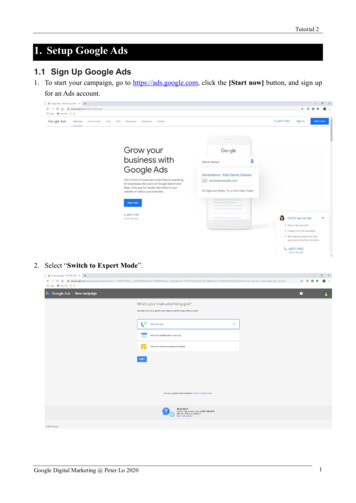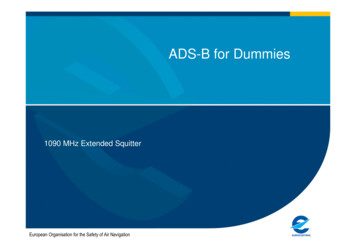
Transcription
ADS Chapter 545Information Systems SecurityPartial Revision Date: 03/11/2021Responsible Office: M/CIO/IAFile Name: 545 031121
03/11/2021 Partial RevisionFunctional Series 500 – Management ServicesADS 545 – Information Systems SecurityPOC for ADS 545: Laura Samotshozo, (202) 916-4517, lsamotshozo@usaid.govTable of Contents545.1OVERVIEW8545.2PRIMARY RESPONSIBILITIES9545.3POLICY DIRECTIVES AND REQUIRED 545.3.1.15545.3.1.16Program Management (PM)Information Security Program Plan (PM-1)Senior Information Security Officer (PM-2)Information Security Resources (PM-3)Plan of Action and Milestones Process (PM-4)Information System Inventory (PM-5)Information Security Measures of Performance (PM-6)Enterprise Architecture (PM-7)Critical Infrastructure Plan (PM-8)Risk Management Strategy (PM-9)Security Authorization Process (PM-10)Mission/Business Process Definition (PM-11)Insider Threat Program (PM-12)Information Security Workforce (PM-13)Testing, Training, and Monitoring (PM-14)Contacts with Security Groups and Organizations (PM-15)Threat Awareness Program 45.3.2.12545.3.2.13Access Control (AC)Access Control Policy and Procedures (AC-1)Account Management (AC-2)Access Enforcement (AC-3)Information Flow Enforcement (AC-4)Separation of Duties (AC-5)Least Privilege (AC-6)Unsuccessful Logon Attempts (AC-7)System Use Notification (AC-8)Session Lock and Termination (AC-11 and AC-12)Permitted Actions Without Identification or Authentication (AC-14)Remote Access (AC-17)Wireless Access (AC-18)Access Control for Mobile Devices (AC-19)17171719192020212122222324242ADS Chapter 545
03/11/2021 Partial Revision545.3.2.14545.3.2.15545.3.2.16Use of External Information Systems (AC-20)Information Sharing (AC-21)Publicly Accessible Content .3.3.4Awareness and Training (AT)Security Awareness and Training Policy and Procedures (AT-1)Security Awareness Training (AT-2)Role-Based Security Training (AT-3)Security Awareness Training Reporting and Non-Compliance .4.9545.3.4.10Audit and Accountability (AU)Audit and Accountability Policy and Procedures (AU-1)Audit Events (AU-2)Content of Audit Records (AU-3)Audit Storage Capacity (AU-4) and Audit Record Retention (AU-11)Response to Audit Processing Failures (AU-5)Audit Review, Analysis, and Reporting (AU-6)Audit Reduction and Report Generation (AU-7)Time Stamps (AU-8)Protection of Audit Information (AU-9)Audit Generation ity Assessment and Authorization (SA&A)Security Assessment and Authorization Policy and Procedures (CA-1)31545.3.5.4545.3.5.5545.3.5.6Security Assessments (CA-2)System Interconnections (CA-3) and Internal System Connections(CA-9)Plan of Actions and Milestones (CA-5)Security Authorizations (CA-6)Continuous Monitoring 45.3.6.9545.3.6.10545.3.6.11Configuration Management (CM)Configuration Management Policies and Procedures (CM-1)Baseline Configuration (CM-2)Configuration Change Control (CM-3)Security Impact Analysis (CM-4)Access Restrictions for Change (CM-5)Configuration Settings (CM-6)Least Functionality (CM-7)Information System Component Inventory (CM-8)Configuration Management Plan (CM-9)Software Usage Restrictions (CM-10)User Installed Software (CM-11)363636373738383839404041545.3.7Contingency Planning (CP)41545.3.5.2545.3.5.33ADS Chapter 545
03/11/2021 Partial 7.5545.3.7.6545.3.7.7545.3.7.8545.3.7.9Contingency Planning Policy and Procedures (CP-1)Contingency Plan (CP-2)Contingency Training (CP-3)Contingency Plan Testing (CP-4)Alternate Storage Site (CP-6)Alternate Processing Site (CP-7)Telecommunications Services (CP-8)Information System Backup (CP-9)Information Recovery and Reconstitution .8.8545.3.8.9Identification and Authorization (IA)Identification and Authorization Policy and Procedures (IA-1)Identification and Authentication (Organizational Users) (IA-2)Device Identification and Authentication (IA-3)Identifier Management (IA-4)Authenticator Management (IA-5)Authenticator Feedback (IA-6)Cryptographic Module Authentication (IA-7)Identification and Authentication (Non-Organizational Users) (IA-8)Digital Signature Using Personal Identity Verification (PIV) 45.3.9.3545.3.9.4545.3.9.5545.3.9.6Incident Response (IR)Incident Response Policy and Procedures (IR-1)Incident Response Training (IR-2)Incident Response Testing (IR-3)Incident Handling (IR-4)/Incident Monitoring (IR-5)Incident Reporting (IR-6)/Incident Assistance (IR-7)Incident Response Plan 5.3.10.3545.3.10.4545.3.10.5545.3.10.6Maintenance (MA)System Maintenance Policy and Procedures (MA-1)Controlled Maintenance (MA-2)Maintenance Tools (MA-3)Non-Local Maintenance (MA-4)Maintenance Personnel (MA-5)Timely Maintenance dia Protection (MP)Media Protection Policy and Procedures (MP-1)Media Access (MP-2)Media Marking (MP-3)Media Storage (MP-4)Portable Media Transport (MP-5)Media Sanitization (MP-6)Media Use (MP-7)56565657575758584ADS Chapter 545
03/11/2021 Partial Revision545.3.12545.3.12.1Physical and Environmental Protection (PE)Physical and Environmental Protection Policy and Procedures (PE-1)5959545.3.12.2 Physical Access Authorizations (PE-2)59545.3.12.3 Physical Access Control (PE-3) and Visitor Access Records (PE-8)59545.3.12.4 Access Control for Output Devices (PE-5)60545.3.12.5 Monitoring Physical Access (PE-6)60545.3.12.6 Access Control for Transmission Medium (PE-4) and Power Equipment andCabling (PE-9)61545.3.12.7 Emergency Shutoff, Power and Lighting (PE-10, 11, 12)61545.3.12.8 Fire Protection (PE-13)61545.3.12.9 Temperature and Humidity Controls (PE-14)61545.3.12.10 Water Damage Protection (PE-15)62545.3.12.11 Delivery and Removal (PE-16)62545.3.12.12 Alternate Work Site .3.13.4Planning (PL)Security Planning and Procedures (PL-1)System Security Plan (PL-2)Rules of Behavior (PL-4)Information Security Architecture 14.3Personnel Security (PS)Personnel Security Policy and Procedures (PS-1)Access Agreements (PS-6)Third Party Personnel Security .3545.3.15.4Risk Assessment (RA)Risk Assessment Policy and Procedure (RA-1)Security Categorization (RA-2)Risk Assessment (RA-3)Vulnerability Scanning 16.8545.3.16.9545.3.16.10System and Services Acquisition (SA)System and Services Acquisition Policy and Procedures (SA-1)Contractors and Outsourced OperationsAllocation of Resources (SA-2)System Development Life Cycle (SA-3)Acquisition Process (SA-4)Information System Documentation (SA-5)Security Engineering Principles (SA-8)External Information System Services (SA-9)Developer Configuration Management (SA-10)Developer Security Testing and Evaluation (SA-11)6969707071717272727373545.3.17System and Communications Protection (SC)745ADS Chapter 545
03/11/2021 Partial Revision545.3.17.1System and Communications Protection Policy and Procedures on Partitioning (SC-2)74Information in Shared Resources (SC-4)74Denial of Service Protection (SC-5)74Boundary Protection (SC-7)75Transmission Confidentiality and Integrity (SC-8)75Network Disconnect (SC-10)76Cryptographic Key Establishment and Management (SC-12)76Cryptographic Protection (SC-13)76Collaborative Computing Devices (SC-15)76Public Key Infrastructure Certificates (SC-17)76Mobile Code (SC-18)77Voice Over Internet Protocol (SC-19)77Secure Name/Address Resolution Service (Authoritative Source) (SC-20) 77Secure Name/Address Resolution Service (Recursive or Caching Resolver)(SC-21)78Architecture and Provisioning for Name/Address Resolution Service (SC-22)78Session Authenticity (SC-23)78Protection of Information at Rest (SC-28)78Process Isolation .3.18.9545.3.18.10545.3.18.11System and Information Integrity (SI)System and Information Integrity Policy and Procedures (SI-1)Flaw Remediation (SI-2)Malicious Code Protection (SI-3)Information System Monitoring (SI-4)Security Alerts, Advisories, and Directives (SI-5)Software, Firmware and Information Integrity (SI-7)Spam Protection (SI-8)Information Input Validation (SI-10)Error Handling (SI-11)Information Handling and Retention (SI-12)Memory Protection 45.3.19.2545.3.19.3545.3.19.4Other USAID-Specific PoliciesAcceptable UseInformation Security Policy Violation and Disciplinary ActionRequirement to Connect Laptops to AIDNet Every 30 DaysElevated Privilege Account Usage 45.3.20.3Prohibited and Restricted Use of TechnologiesSocial Media and Social NetworkingMobile DevicesWireless Network Communications and 545.3.17.15545.3.17.166ADS Chapter 545
03/11/2021 Partial r Technologies90Third-Party Websites90Cloud Computing91Applications or Services Sending Emails Using USAID.gov Email Address92545.3.22545.3.22.1PII and Sensitive InformationTypes of Sensitive Information9293545.3.23Waivers93545.4MANDATORY REFERENCES94545.4.1External Mandatory References94545.4.2Internal Mandatory References96545.5ADDITIONAL HELP98545.6DEFINITIONS987ADS Chapter 545
03/11/2021 Partial RevisionADS 545 – Information Systems Security545.1OVERVIEWEffective Date: 07/07/2020The Federal Information Security Modernization Act of 2014 (FISMA) requires eachFederal agency to develop, document, and implement an agency-wide program toprovide information security for the information and information systems (ISs) that supportthe operations and assets of the agency, including those provided or managed by anotheragency, contractor, or other source. USAID has developed policies and standards,outlined in this document, to comply with FISMA and to provide secure InformationTechnology (IT) services to facilitate USAID’s mission.This policy applies to all USAID staff and IT services, ISs, and information owned by oroperated on behalf of USAID. It is designed to protect the Agency’s IT assets andinformation from unauthorized access, use, disclosure, disruption, modification, and/ordestruction.Applicability Statement: Throughout this chapter, the term "workforce" refers toindividuals working for or on behalf of the Agency, regardless of hiring or contractingmechanism, who have physical and/or logical access to USAID facilities and ISs. Thisincludes Direct-Hire employees, Personal Services Contractors, Fellows, ParticipatingAgency Service Agreement, and contractor personnel. Contractors are not normallysubject to Agency policy and procedures as discussed in ADS Chapter 501, TheAutomated Directives System. However, contractor personnel are included here byvirtue of the applicable clauses in the contract related to HSPD-12 and InformationSecurity requirements.The standards established in this ADS chapter represent the minimum standards forinformation systems security for a USAID IS, in accordance with National Institute ofStandards and Technology (NIST) Special Publication (SP) 800-53, Revision 4.However, when an information system is categorized as Low or High for security impact,these standards will be tailored in accordance with minimum security controls, as definedby NIST SP 800-53, Revision 4, for the specific security categorization.USAID must comply with Binding Operational Directives (BODs) and EmergencyDirectives (EDs), issued by the U.S. Department of Homeland Security.Refer to ADS 552, Cyber Security for National Security Information (NSI) Systemsfor compliance requirements for classified ISs.Any specific responsibilities for risk management mentioned in this ADS chapter will beexercised consistent with the Agency Enterprise Risk Management governance structuredetailed in ADS 596mab, Governance Charter for Enterprise Risk Management andInternal Control at USAID.8ADS Chapter 545
03/11/2021 Partial Revision545.2PRIMARY RESPONSIBILITIESEffective Date: 07/07/2020All government offices, United States Direct-Hires (USDH), and other employees bear theprimary responsibilities for information systems security. Although contractors, PersonalService Contractors (PSCs), and others working on behalf of USAID may support securityfunctions, a USAID employee must always be designated as the responsible agent for allsecurity requirements and functions. Unless otherwise stated, security specific roles mustbe filled by USDH personnel.a. The Administrator is responsible for providing information security protections forthe Agency. The Administrator establishes:1) The organizational commitment to information security and the actions requiredto effectively manage risk and protect the core missions and business functionsbeing carried out by the organization;2) The appropriate accountability for information security and provides activesupport and oversight of monitoring and improvement for the informationsecurity program; and3) Senior leadership commitment to information security to establish a level of duediligence within USAID that promotes a climate for mission and businesssuccess.b. The Chief Information Officer (CIO) is responsible for the appropriate allocation ofresources, based on Agency priorities, dedicated to the protection of the informationsystems supporting USAID’s missions and business functions. The CIO also designatesthe senior information security officer or Chief Information Security Officer (CISO).c. The Chief Information Security Officer (CISO) is the Agency’s senior informationsecurity official. The CISO:1) Carries out CIO security responsibilities under FISMA;2) Carries out Risk Executive functions for the Agency;3) Serves as the primary liaison for the CIO to USAID’s Authorizing Officials(AOs), Information System Owner (SO), common control providers, andInformation System Security Officers (ISSOs). The CISO (or supporting staffmembers) may also serve as an AO-designated representative or securitycontrol assessor; and4) Ensures promulgation and enforcement of the policy in this chapter.d. The Chief Privacy Officer (CPO) is responsible for establishing strategic directionand maintaining oversight of the USAID Privacy Program to ensure that it is in compliance9ADS Chapter 545
03/11/2021 Partial Revisionwith all applicable statutory and regulatory guidance. This includes reviewing privacycompliance documentation (including privacy threshold analyses (PTAs), privacy impactassessments (PIAs), Privacy Act system of record notices (SORNs), and privacystatements for websites and forms) that must be approved by the CPO and his/her staffprior to a system receiving an authority to operate (ATO). The CPO is responsible formanaging responses to incidents involving Personally Identifiable Information (PII or othersensitive information), and for privacy-related issues and responses to audits andprogram reviews.e. The Senior Accountable Official for Risk Management (SAORM) has Agencywide responsibility and accountability for implementation of USAID’s cybersecurity riskmanagement measures. These responsibilities include ensuring that cybersecurity riskmanagement processes are aligned with strategic, operational, and budgetary planningprocesses in accordance with chapter 35, subchapter II, of title 44, United States Code(U.S.C). In USAID, the CIO is the SAORM.f.The Senior Agency Official for Privacy (SAOP) has overall responsibility andaccountability for working with the CPO to ensure the Agency’s implementation ofinformation privacy protections and Agency compliance efforts. These responsibilitiesinclude ensuring full Agency compliance with Federal laws, regulations, and policiesrelating to information privacy, such as the Privacy Act. The SAOP is also responsible forevaluating the privacy impact of all new technology and its impact on PII. The SAOPmanages the Agency’s response to Office of Management and Budget(OMB)/Department of Homeland Security (DHS) reporting requirements. The SAOP isalso responsible for ensuring that all staff receives the appropriate privacy training, bothannual and role based.g. The Information Owner (IO) is an Agency official that has been given statutory,management, or operational authority for specified information and the responsibility forestablishing the policies and procedures governing its generation, collection, processing,dissemination, and disposal. The owner/steward of the information processed, stored, ortransmitted by an information system may or may not be the same as the SO.h. The Business Owner has varying responsibilities depending on the Mission orBusiness or Information Owner. In general, Business Owners are responsible forensuring the mission of the organization is accomplished. In some cases, BusinessOwners are responsible for funding and other resources that support their line ofbusiness.i.The Authorizing Official (AO) is the senior executive with the authority to formallyassume responsibility for operating an information system at an acceptable level of risk toAgency operations and assets, individuals, and other organizations. In USAID, the CIO isthe AO for information systems. Only the AO may officially accept risks on behalf of theAgency. AOs can deny authorization to operate an information system or, if the system isoperational, halt operations if unacceptable risks exist.10ADS Chapter 545
03/11/2021 Partial Revisionj.The Common Control Provider is an individual, group, or organization responsiblefor the development, implementation, assessment, and monitoring of common controls(i.e., security controls inherited by information systems). Common control providers areresponsible for the following:1) Documenting the organization-identified common controls in a security plan (orequivalent document prescribed by the organization);2) Ensuring that required assessments of common controls are carried out byqualified assessors with an appropriate level of independence defined by theorganization;3) Maintaining a Plan of Action and Milestones (POA&M) for all controls havingweaknesses or deficiencies. Security plans, security assessment reports, andplans of action and milestones for common controls (or a summary of suchinformation) is made available to information SOs inheriting those controls afterthe information is reviewed and approved by the senior official or executive withoversight responsibility for those controls; and4) Remediating weaknesses identified for associated common controls.k. The System Owner (SO) is an organizational official responsible for theprocurement, development, integration, modification, operation, maintenance, anddisposal of an information system. The SO must maintain a separation of duties from theAO and must not hold any other significant responsibility for a system for which an AOrole is also held. The SO is responsible for addressing the operational interests of theuser community (i.e., users who require access to the information system to satisfyMission, business, or Agency requirements) and for ensuring compliance with informationsecurity requirements. In coordination with the Information System Security Officer(ISSO), the SO is responsible for the development and maintenance of the security planand ensures that the system is deployed and operated in accordance with the agreedupon security controls. In coordination with the information owner/steward, the SO is alsoresponsible for deciding who has access to the system (and with what types of privilegesor access rights) and ensures that system users and support personnel receive therequisite security training, i.e., instruction in Rules of Behavior (ROB).The roles of SO and ISSO are separate and must be separately designated and assignedfor the Missions and systems across the Agency. The roles may not be held by the sameperson.M/CIO provides training to ISSOs and/or EXOs.l.The Information System Security Officer (ISSO) is an individual responsible forensuring that the appropriate operational security posture is maintained for an informationsystem and, as such, works in close collaboration with the information SO and all otherrelated system POCs, including developers, engineers, and administrators. The ISSO11ADS Chapter 545
03/11/2021 Partial Revisionalso serves as a principal advisor on all matters, technical and otherwise, involving thesecurity of an information system. The ISSO has the detailed knowledge and expertiserequired to manage the security aspects of an information system and, in manyorganizations, is assigned responsibility for the day-to-day security operations of asystem. The ISSO may be a non-USDH staff member, but the ISSO must be a clearedU.S. citizen with a clearance at least equal to the highest security classification of theinformation being protected.m. The Information Security Architect is an individual, group, or organizationresponsible for ensuring that the information security requirements necessary to protectthe organization’s core missions and business processes are adequately addressed in allaspects of enterprise architecture, including reference models, segment and solutionarchitectures, and the resulting information systems (ISs) supporting those missions andbusiness processes.n. The Information System Security Engineer is an individual, group, or organizationresponsible for conducting information system security engineering activities. Informationsystem security engineers are an integral part of the development team (i.e., integratedproject team) designing and developing organizational information systems or upgradinglegacy systems.o. The Security Control Assessor is an individual, group, or organization responsiblefor conducting a comprehensive assessment of the management, operational, andtechnical security controls employed within or inherited by an information system.Security control assessors provide an assessment of the weaknesses or deficienciesdiscovered in the information system and its environment of operation and recommendcorrective actions to address identified vulnerabilities. Results of the assessment must bedocumented in a security assessment report.545.3POLICY DIRECTIVES AND REQUIRED PROCEDURESEffective Date: 10/10/2017Information security policies delineate the security management structure and foundationto measure progress and compliance. The CISO maintains the policies in this ADSchapter and may alter the policies to comply with Federal regulations, mandates, anddirectives by way of periodic updates and/or Agency Notices, as required, in order tomaintain the security of the Agency’s information security profile.At the discretion of the Administrator (A/AID) or designees, certain USAID SecurityAuthorization roles may be delegated (i.e., role representatives) and, if so, must bedocumented and maintained on file as part of the official record. Bureau officials mayappoint qualified individuals to perform activities associated with any USAID SecurityAuthorization role, with the exception of the Chief Information Officer (CIO), ChiefInformation Security Officer (CISO), Chief Privacy Officer (CPO), and Authorizing Official(AO).Please note: Sections 545.3.1 through 545.3.18 correspond to required security controls,12ADS Chapter 545
03/11/2021 Partial Revisionper NIST 800-53, rev 4. The abbreviation following each section heading includes theidentifier for that control (i.e., PM for Program Management, AC for Access Control, ATfor Awareness and Training, etc.).545.3.1Program Management (PM)545.3.1.1Information Security Program Plan (PM-1)Effective Date: 10/10/2017The Chief Information Security Officer (CISO) must develop, document, disseminate,protect, review annually, and update, as required, an organization-wide informationsecurity program plan that:a. Provides an overview of the requirements for the security program and a descriptionof the security program management controls and common controls in place orplanned for meeting those requirements;b. Includes the identification and assignment of roles, responsibilities, managementcommitment, coordination among organizational entities, and compliance;c. Reflects coordination among organizational entities responsible for the differentaspects of information security (i.e., technical, physical, personnel, cyber-physical);andd. Is approved by a senior official with responsibility and accountability for the riskbeing incurred to organizational operations (including mission, functions, image, andreputation), organizational assets, and individuals.545.3.1.2Senior Information Security Officer (PM-2)Effective Date: 10/10/2017The Chief Information Officer (CIO), or designee, must appoint an experienced SeniorInformation Security Officer or Chief Information Security Officer with the responsibility forthe development, management, and implementation of the Information Security ProgramPlan.545.3.1.3Information Security Resources (PM-3)Effective Date: 10/10/2017The Agency must ensure that all capital planning and investment requests include theresources needed to implement the information security program and documents allexceptions to this requirement; employ a business case to record the resources required;and ensure that information security resources are available for expenditure as planned.System Owners (SOs), Business Owners, or Authorizing Officials (AOs) are responsiblefor ensuring these requirements are met for all IT assets deployed for Agency operations.For details, see ADS 547, Property Management of Information Technology (IT), ADS13ADS Chapter 545
03/11/2021 Partial Revision562, Physical Security Programs (Overseas), NIST SP 800-65, and OMB Exhibit 300.545.3.1.4Plan of Action and Milestones Process (PM-4)Effective Date: 06/18/2019The CISO must:a. Implement a process for ensuring that plans of action and milestones for the securityprogram and associated organizational information systems are developed andmaintained;b. Document the remedial information security actions to adequately respond to risk toorganizational operations and assets, individuals, other organizations, and thenation, and report these actions in accordance with OMB FISMA reportingrequirements; andc. Review plans of action and milestones for consistency with the organizational riskmanagement strategy and organization-wide priorities for risk response actions.For more information, please see the POA&M Management Guide for DocumentingWeakness and USAID FISMA Program Guide. To obtain copies of these documents, goto and-authorization-saa orsend an email to ato@usaid.gov.545.3.1.5Information System Inventory (PM-5)Effective Date: 10/10/2017The Bureau for Management, Office of the Chief Information Officer (M/CIO) mustdevelop and maintain an inventory of Agency information systems, including approvedsocial media sites and cloud-based systems/services. The Chief Financial Officer (CFO)must maintain an inventory of all Agency Financial Management Systems. The CISOmust maintain an inventory of all FISMA reportable information systems.545.3.1.6Information Security Measures of Performance (PM-6)Effective Date: 10/10/2017The CISO must develop, monitor, and report the results of information security measuresof performance as part of the Agency Information Security Program. Reporting mustinclude outcome-based metrics demonstrating the effectiveness of security controls inuse, which includes periodic OMB FISMA data collected from SOs. For more information,see NIST SP 800-55.545.3.1.7Enterprise Architecture (PM-7)Effective Date: 10/10/2017M/CIO must develop an enterprise architecture integrated with information security at anorganization-wide level. This information security architecture must address risk to14ADS Chapter 545
03/11/2021 Partial RevisionAgency individuals, assets, and operations while protecting Agency core missions andbusiness processes and aligning with Federal Enterprise Architecture to protect otherorganizations and the nation. For details, see OMB Enterprise ArchitectureAssessment Framework and the M/CIO Strategic Planning and EnterpriseArchitecture.545.3.1.8Critical Infrastructure Plan (PM-8)Effective Date: 10/10/2017If the USAID Administrator officially declares that the Agency mission includes CriticalInfrastructure, M/CIO (or other designees) has specific responsibilities. In coordinationwith the CISO and based on priority strategy, guidance, and the Risk ManagementFramework, M/CIO must address information security issues when developing,documenting, and updating the critical infrastructure. This includes the creation of a keyresources protection plan. For more information, contact ato@usaid.gov.545.3.1.9Risk Management Strategy (PM-9)Effective Date: 10/10/2017M/CIO must develop, implement, review annually, and update, as required, an Agencywide risk management strategy to protect information assets. M/CI
545.3.16.6 Information System Documentation (SA-5) 72 545.3.16.7 Security Engineering Principles (SA-8) 72 545.3.16.8 Extern










